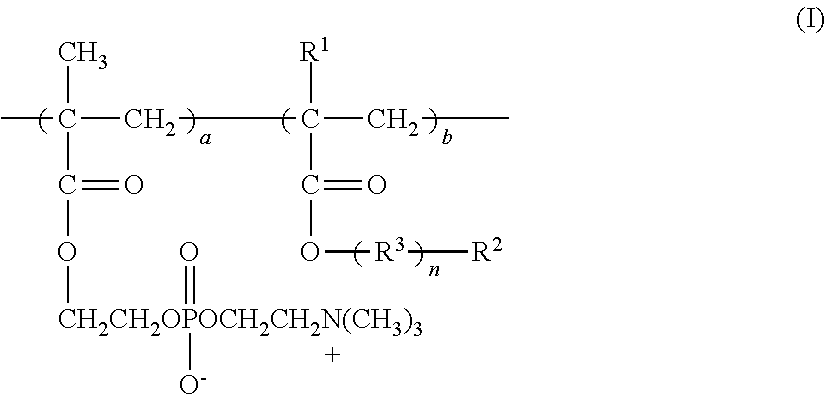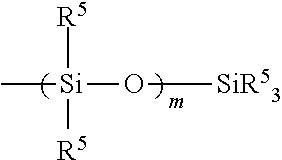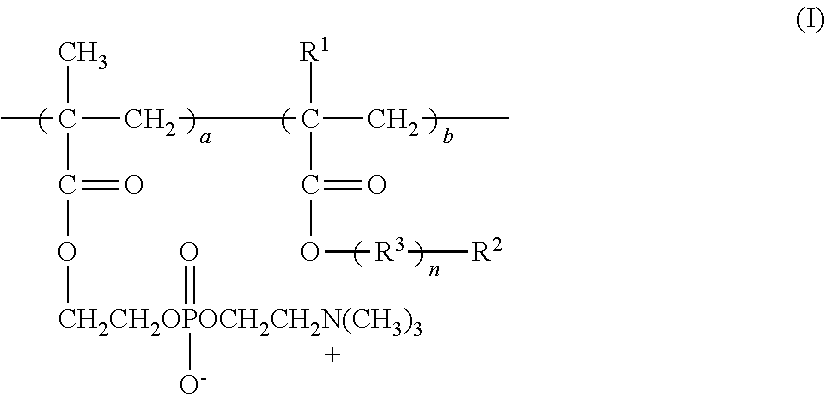Intraocular lens and process for producing the same
a technology of intraocular lens and process, which is applied in the field of intraocular lens, can solve the problems of affecting the operation of vitreous body, affecting the appearance of the eye, and affecting the operation of the vitreous body, so as to inhibit the opacification phenomenon and inhibit the secondary cataract
- Summary
- Abstract
- Description
- Claims
- Application Information
AI Technical Summary
Benefits of technology
Problems solved by technology
Method used
Image
Examples
example 1
[0104]A soft acryl lens having haptic portions formed of PMMA (colored in blue) and an optic portion (capable of absorbing ultraviolet) was produced from compositions shown in Table 1 by a cutting-polishing method.
[0105]A very small amount of an ethanol solution containing 0.2 mass % of a copolymer obtained from MPC monomer and n-butyl(meth)acrylate (MPC:n-butyl acrylate=3:7 by molar ratio, number average molecular weight=600,000) was dropped on the front surface of the above soft acryl intraocular lens, and the turning of the lens with a spin coater at a rate of 5,000 rpm for 10 seconds was repeated twice, to give an intraocular lens having an MPC coating film formed on the front surface thereof (coating film thickness: 13 nm). Then, the thus-obtained lens was set on a specialized tool, the tool with the lens on it was placed in a photo surface-treatment experimental apparatus PL16-110 (supplied by SEN LIGHTS CORPORATION) and the back surface of the lens was treated for 180 seconds...
example 2
[0110]A soft acryl lens having haptic portions formed of PMMA (colored in blue) and an optic portion (capable of absorbing ultraviolet light) was produced from compositions shown in Table 1 by a cutting-polishing method.
[0111]A very small amount of an ethanol solution containing 0.2 mass % of a copolymer obtained from MPC monomer and n-butyl(meth)acrylate (MPC:n-butyl acrylate=3:7 by molar ratio, number average molecular weight=600,000) was dropped on the front surface of the above soft acryl intraocular lens, and the turning of the lens with a spin coater at a rate of 5,000 rpm for 10 seconds was repeated twice, to give an intraocular lens having an MPC coating film formed on the front surface thereof. Then, the above lens was set on a specialized tool, the tool with the lens on it was placed in a plasma apparatus PA100AT supplied by KYOTO ELECTRONICS MANUFACTURING CO., LTD., and the back surface of the lens was plasma-treated with argon gas for 300 seconds (50 W). The thus-obtaine...
example 3
[0113]A yellow soft acryl lens having haptic portions formed of PMMA (colored in blue) and an optic portion (yellow) was produced from compositions shown in Table 1 by a cutting-polishing method.
[0114]A very small amount of an ethanol solution containing 0.2 mass % of a copolymer obtained from MPC monomer and n-butyl(meth)acrylate (MPC:n-butyl acrylate=3:7 by molar ratio, number average molecular weight=600,000) was dropped on the front surface of the above soft acryl intraocular lens, and the turning of the lens with a spin coater at a rate of 5,000 rpm for 10 seconds was repeated twice, to give an intraocular lens having an MPC coating film formed on the front surface thereof.
[0115]Then, the thus-obtained lens was set on a specialized tool, the tool with the lens on it was placed in a photo surface-treatment experimental apparatus PL16-110 (supplied by SEN LIGHTS CORPORATION) and the back surface of the lens was treated for 180 seconds. The thus-obtained lens was sterilized with E...
PUM
| Property | Measurement | Unit |
|---|---|---|
| concentration | aaaaa | aaaaa |
| thickness | aaaaa | aaaaa |
| thickness | aaaaa | aaaaa |
Abstract
Description
Claims
Application Information
 Login to View More
Login to View More - R&D
- Intellectual Property
- Life Sciences
- Materials
- Tech Scout
- Unparalleled Data Quality
- Higher Quality Content
- 60% Fewer Hallucinations
Browse by: Latest US Patents, China's latest patents, Technical Efficacy Thesaurus, Application Domain, Technology Topic, Popular Technical Reports.
© 2025 PatSnap. All rights reserved.Legal|Privacy policy|Modern Slavery Act Transparency Statement|Sitemap|About US| Contact US: help@patsnap.com



